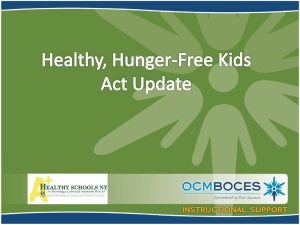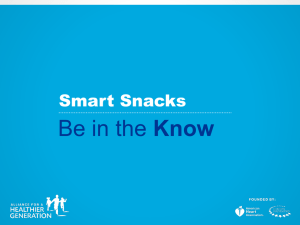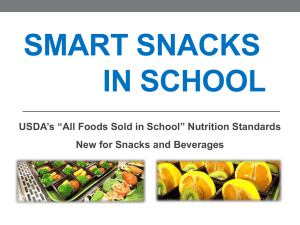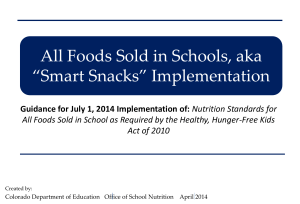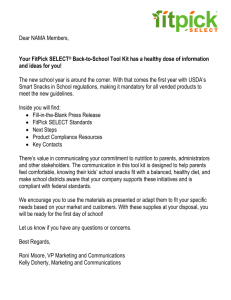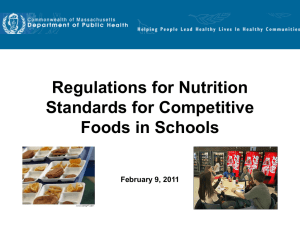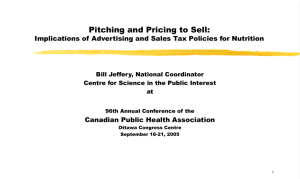Smart Snacks Resources - Gwinnett County Public Schools
advertisement
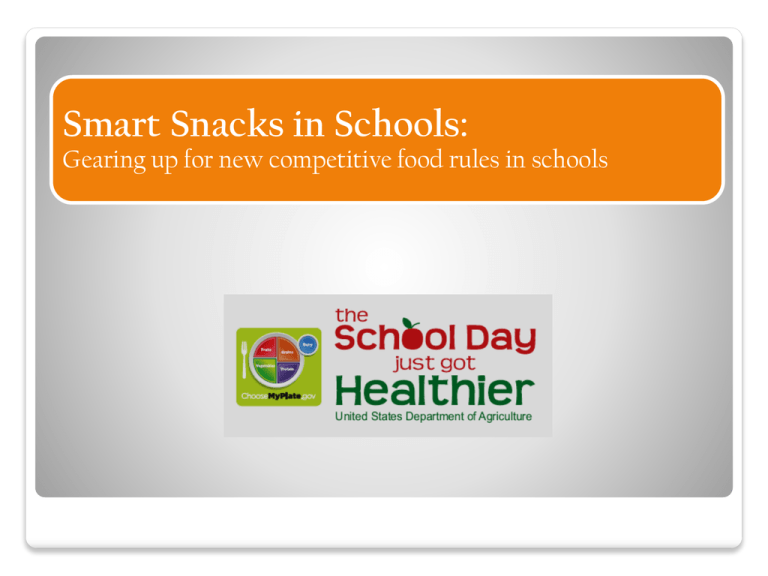
Smart Snacks in Schools: Gearing up for new competitive food rules in schools Healthy, Hungry Free Kids Act (2010) Changes School Food Environment Improve child nutrition and advance nutrition quality of school meals ◦ USDA oversight of ALL foods & beverages sold/served in schools ◦ Nutrition standards for ALL foods & beverages sold outside of the Federal child nutrition programs in schools USDA’s objectives: ◦ Focus on reimbursable meal program as the major source of food & beverages offered at schools ◦ Encourage consumption of healthy snacks and beverages to students outside the meal program 2 At-A-Glance: Competitive Foods Regulations • Applies to ALL food and beverages sold on campus during the school day & accessible to students • • A la carte School stores Snack bars Vending machines Other venues Applies to ALL grade levels General standards & specific nutrient standards Some exemptions apply • These are minimum standards 3 When do the standards apply? School day is the period from the midnight before, to 30 minutes after the end of the official school day. Fundraisers All foods & beverages meeting nutrition requirements may be sold at fundraisers on the school campus during school hours Standards do not apply to items sold during nonschool hours, weekends, or off-campus fundraising events State agencies may establish limits on the number of fundraising activities that allow the sale of food & beverages that do not meet the nutrition standards 5 Exemptions from nutrients standards Fruits and vegetables Fresh, frozen and canned fruit packed in water, 100% juice, or light syrup Fresh, frozen and canned vegetables with no added ingredients except water or with a small amount of sugar for processing Chewing gum 6 •General Standards Nutrient Standards Summary Table of Nutrition Standards for ALL Competitive Foods Sold in Schools MUST MEET ALL: Calories Snacks and side dishes: <200 Fat Per Portion as Served Trans Fat Sodium (mg) Snacks and side dishes: Until Sat Fat Sugar July 1, 2016: <230mg <35% calories2 0g as served (<0.5 g per portion) < 10% calories3 Entrée items1: <350 After July 1, 2016: <200mg < 35% total sugars by weight4 Entrée items: <480 mg Must also be ONE of the following: A. Must be a combination food containing >1/4 cup fruit or vegetable B. Must be a grain product that contains: Whole grain (>50% whole grain by weight OR whole grain is first ingredient OR 1st ingredient after water) C. Must be at least one of the following non-grain main food groups: • Fruit, Vegetable, Dairy or Protein Foods (As first ingredient or second after water) D. Must contain ≥10% DV of one of the following nutrients: Calcium • Potassium • Vitamin D • Dietary Fiber (Note: This criteria will be obsolete on July 1, 2016 and may not be used to qualify foods) 1Entrées defined as combination foods of: grain + meat; grain + fruit or vegetable; meat + fruit or vegetable; or meat alone not apply to reduced fat cheese, nuts/seeds, seafood 3Does not apply to reduced fat cheese, nuts/seeds 4Does not apply to certain dried fruits and vegetables 2Does 7 Summary Table of Nutrition Standards for Beverages Sold in Schools Beverage Elementary School Middle School High School Plain water, carbonated or not no size limit no size limit no size limit Low fat milk, unflavored* ≤ 8 oz ≤ 12 oz ≤ 12 oz Non fat milk, unflavored or flavored * ≤ 8 oz ≤ 12 oz ≤ 12 oz 100% fruit/vegetable juice ** ≤ 8 oz ≤ 12 oz ≤ 12 oz Other calorie-free beverages Not allowed Not allowed ≤ 20 oz Other lower calorie beverages Not allowed Not allowed ≤ 12 oz *Includes nutritionally equivalent milk alternatives, as permitted by NSLP/SBP **May include 100% juice diluted with water (with or without carbonation) & with no added sweeteners 8 Smart Snacks Resources •Alliance for a Healthier Generation •Product navigator- lists specific products that meet guidelines Smart Snacks Calculator Need ingredient list and nutrition facts panel Documents Required from Vendors Nutrition labels & Ingredient Statements of products being sold Alliance Calculator Statement If used What do “Smart Snacks” in schools look like? Before the New Standards After the New Standards From USDA Smart Snacks Infographic Reduce consumption of sodium and calories coming from fat, saturated fat and sugar Promote consumption of products with whole grain, low fat dairy, fruits, vegetables or protein foods as their main ingredients 12 Before: Vending machine in a HS •1 cafeteria with 3 vending machines •108 facings total…0 products met guidelines After- Vending Machine in a HS Trends in Snacking – Good news for nutrition! Top Growing and Declining Snack Foods - Total Kids1 8.9 6.8 6.6 1.3 Fruit Granola Bars Popcorn Cookies Candy/ Gum Frozen Ice Cream/ Novelties Yogurt Vegetables -2 -3.9 Yogurt is the most popular healthy snack among kids and teens. -7.6 1. Mintel, Attitude Toward Kid and Teen Snacking, Feb. 2013 -12.2 Other Resources USDA School Nutrition Alliance for Healthier Generations http://www.fns.usda.gov/nslp/national-school-lunch-program https://www.healthiergeneration.org/ Gwinnett County Public Schools http://publish.gwinnett.k12.ga.us/gcps/home/public Thank you!
